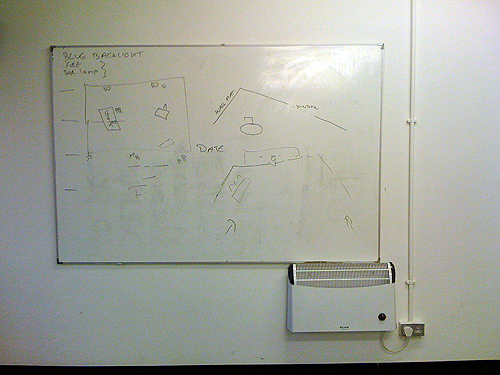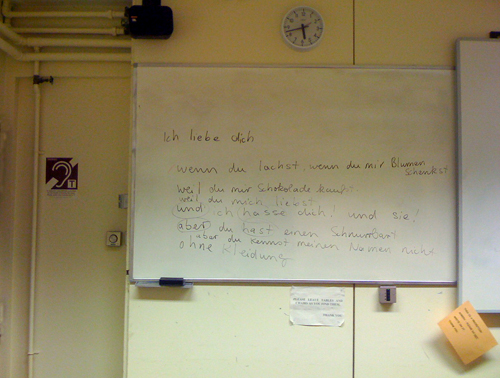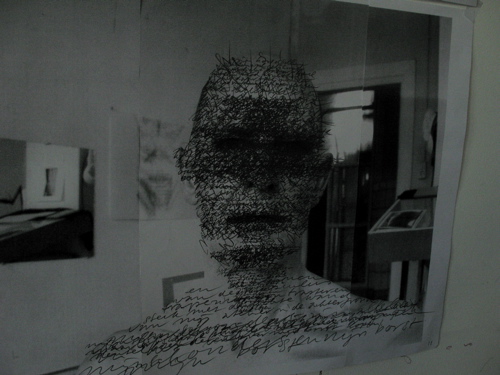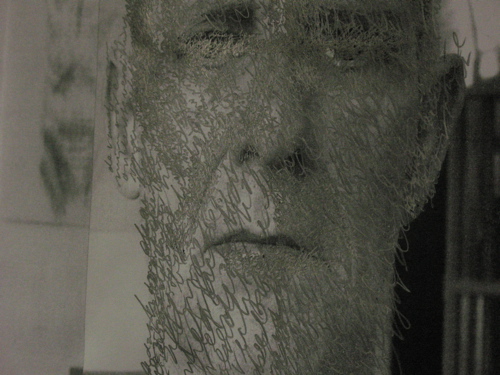This is the piece I mentioned before; the programme note I wrote to introduce Jerome Bel‘s forthcoming presentations at Sadler’s Wells in London.
*
Nothing flows but everything follows.
Towards the beginning of Jerome Bel’s the show must go on (2001) as well as during some intense moments in his later work Veronique Doisneau (2004), we are invited to stare at the bare stage – at the expanse of black dance floor, so many metres by so many metres — which so often plays the unremarkable part of an invisible nothingness in contemporary theatre and dance. We have time to look, look and look again. Nothing happens. Time does its thing. We look some more. Even what’s commonly taken for nothing, Bel seems to remind us, is very often something.
Or start like this. Since I first saw Jerome Bel’s work more than ten years ago it has had a special place in my heart and in any map I might make of contemporary performance. Each of his projects, though they differ enormously, creates a rigorous, puzzling and engaging experience at a very particular intersection of dance, theatre and contemporary art. Often exploring the structures of presence, language and representation, each work celebrates the combination of the entirely obvious and the absolutely extraordinary – sculpting a piece of time through which boredom and banality knot and unravel, only to dissipate around a flickering core of amazement.
Or start like this. In one part of his book Species of Spaces and Other Pieces, the French writer Georges Perec gives instructions on how to look at a city or a street.
“Note down what you can see.” he writes, “Anything worthy of note going on. Do you know how to see what’s worthy of note? Is there anything that strikes you? Nothing strikes you. You don’t know how to see.
You must set about it more slowly, more stupidly. Force yourself to write down what is of no interest, what is most obvious, most common, most colourless…. Don’t say, don’t write ‘etc’. Make an effort to exhaust the subject, even if it seems grotesque or pointless, or stupid. You still haven’t looked at anything, you’re merely picked out what you long ago picked out. Force yourself to see more flatly…”
The ambition here – that of seeing flatly, of seeing more slowly, or more stupidly – is supremely present in Jerome Bel’s significant body of work created since 1994. Each of his performances – which combine their formal obsessiveness with wry and dry humour – are governed for the most part by the observance of a simple rule, task or idea. There is, to use simple terms, the show with the ten household objects, the show with the pop songs and the dances that literalise their lyrics, the show with the four naked performers, the show where he interviews another dancer, the show where all four performers are pretending to be someone else, and so on. Through the dramaturgical exploitation of the simple limits he sets up, Bel pushes us to look again and again at the things which we have forgotten how to see. Of course it’s not the scene of a Paris street that he directs us to, but rather stuff that’s just in front of our noses – the stage itself, the combination of human bodies on it and those arranged looking at it, the properties of clothing or domestic objects, pop music and classical music, language and its relation to the world, theatre and dance themselves; their expectations, logic and construction. And time perhaps; we get to see time.
Time is key in Bel’s stage-economy, as is an eye for systems. Everything takes its time.
Nothing flows, but everything follows. We go piece by piece. Methodically. Each new image, utterance, action or sequence either arises or breaks playfully from the pattern established before. The stage is a little empire of signs. We watch them shifted, shunted, rearranged. Additions and subtractions, escalations and reversals. Questions leading to answers, to more questions, more answers. Big pleasures in small things. Small things grown large by their context. The delights of transformation. The absurdities of repetition. Machinery and human behaviour. There’s always something calm and human scale about the proceedings in any case; a softness and a humour which cut through, or cut against (or inhabit or inhibit) the systematic.
Above all perhaps, we get to understand something we know but are prone to forgetting; that one thing is different to another. We become re-attuned to detail. We see for example, that the red that smudged lipstick leaves on human skin is not the same red produced when skin is slapped. Or we notice something simple, with a shock that seems almost stupid; that a man lain on the floor beneath a blanket is not the same thing as a man lain on the floor without one. Or we see again, only vividly, as something simple and present, that what reads in one culture (say white European) is not at all the same as what reads elsewhere (say Thailand, in traditional Thai dance). We’re made to spend time with these facts, made to look at them better, flatter, more stupidly. There is no delirium; there’s little that might pass for abandon. Indeed, no matter which of Bel’s performances you look at, after each unfolding action, image, dialogue or exchange, there always comes a breath, a silence. This punctuation – a second or two of stillness, a measure of unfilled time – is an imperative beat which nods both to the comedian’s double-take and wait for laughter, and the philosopher’s pause for reflection. Silence. And waiting. These are points to which we always return while witnessing Bel’s pieces. Silence in which the possible multiplies. Silence in which the distribution of the sensible is remade. Silence in which we are left thinking, aware of the space which we are left to fill.



